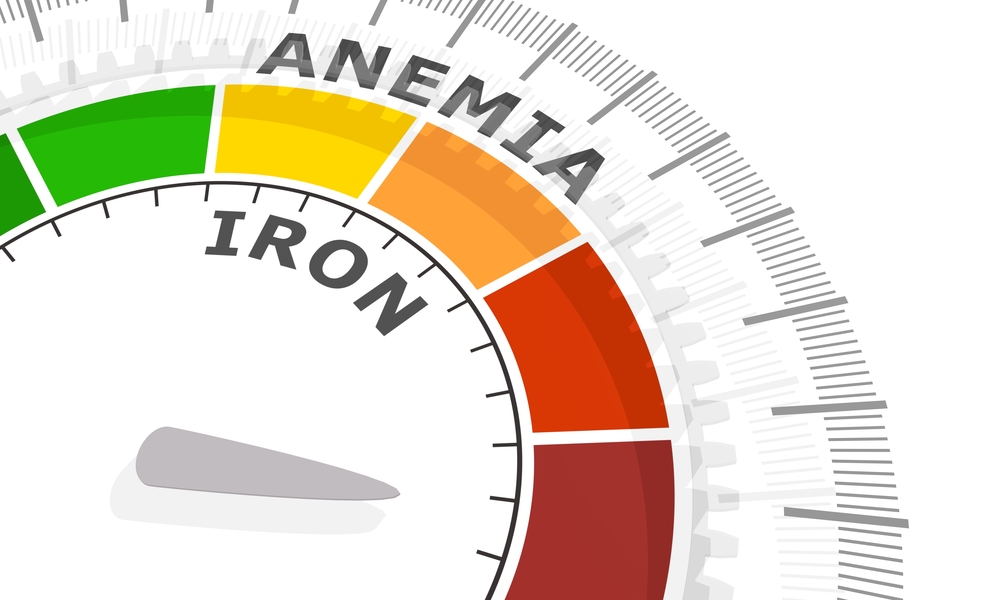 Iron deficiency anemia is a common health concern that occurs when your body lacks adequate healthy red blood cells. These red blood cells are responsible for carrying oxygen to your body’s tissues, and insufficient iron levels can lead to a decrease in their production. As you try to understand this condition better, it’s important to consider its symptoms, causes, and potential treatments.
Iron deficiency anemia is a common health concern that occurs when your body lacks adequate healthy red blood cells. These red blood cells are responsible for carrying oxygen to your body’s tissues, and insufficient iron levels can lead to a decrease in their production. As you try to understand this condition better, it’s important to consider its symptoms, causes, and potential treatments.
Experiencing iron deficiency anemia might leave you feeling fatigued, short of breath, and with an increased heart rate. These symptoms are due to your body’s inability to produce enough hemoglobin, a critical substance in red blood cells that transports oxygen throughout your system. Several factors contribute to iron deficiency anemia, such as insufficient iron intake from your diet, blood loss, or issues with iron absorption.
Being aware of the risks and implementing preventive measures is key in reducing your chances of developing iron deficiency anemia. Ensuring a healthy diet with good sources of iron and vitamin C, addressing any underlying causes of blood loss, and seeking appropriate medical interventions when necessary will help you maintain optimal iron levels and overall health.
Understanding Iron Deficiency Anemia
Causes
Iron deficiency anemia is a condition that occurs when your body lacks enough healthy red blood cells due to insufficient iron. Without adequate iron, your body cannot produce enough hemoglobin, a substance in red blood cells that enables them to carry oxygen to your body’s tissues. Some common causes of iron deficiency anemia include:
- Blood loss: Losing blood through menstrual periods, injuries, or surgeries can lead to iron deficiency anemia, as your body needs more iron to replace lost blood cells.
- Poor iron absorption: Some people have trouble absorbing iron from food due to certain conditions like celiac disease or after gastrointestinal surgeries.
- Diet: Not consuming enough iron-rich foods can lead to iron deficiency, especially in pregnant individuals who have increased iron needs.
Symptoms
People with mild or moderate iron-deficiency anemia may not experience any symptoms. However, more serious cases can cause symptoms such as:
- Fatigue
- Dizziness or lightheadedness
- Shortness of breath
- Chest pain
- Cold hands and feet
( source )
Other signs of iron deficiency anemia include pale skin, brittle nails, and frequent headaches.
Risk Factors
Certain factors can increase your risk of developing iron deficiency anemia:
- Age: Young children and older adults are at a higher risk, as their bodies require more iron during periods of rapid growth or due to age-related changes.
- Pregnancy: Pregnant individuals have an increased need for iron, making them more susceptible to iron deficiency if they don’t consume enough iron-rich foods or take supplements.
- Menstruation: Individuals with heavy menstrual periods may lose more blood, and thus more iron, increasing their risk of developing anemia.
- Vegetarian or vegan diets: Those who follow plant-based diets may not consume enough iron-rich foods, as iron from plant sources is less easily absorbed by the body.
To minimize your risk of iron deficiency anemia, ensure you consume a balanced diet that includes iron-rich foods, consider taking iron supplements if recommended by your healthcare provider, and address any underlying health conditions that may affect iron absorption.
Diagnosis and Blood Tests
Complete Blood Count
To diagnose iron deficiency anemia, your doctor may perform a blood test called a Complete Blood Count (CBC). This test measures several components of your blood, such as red blood cell count, size, and hemoglobin levels. In iron deficiency anemia, red blood cells are smaller and paler in color than normal 1. A CBC provides an overall picture of your blood health and can help your doctor identify if you have anemia.
Serum Ferritin
Another blood test your doctor might order is the serum ferritin test. Ferritin is a protein that stores iron in your body, and its levels indicate the amount of stored iron in your body2. A ferritin threshold of less than 45 ng per mL is considered as an indicator of iron deficiency anemia3. If your serum ferritin levels are low, it may indicate that your body has insufficient stored iron, leading to anemia.
Total Iron-binding Capacity
Your doctor may also assess your total iron-binding capacity (TIBC). This test measures the maximum amount of iron that can be bound by proteins in your blood, particularly transferrin4. In iron deficiency anemia, TIBC is usually increased, as your body tries to absorb more iron to compensate for the deficiency.
Hemoglobin levels
Lastly, the diagnosis of iron deficiency anemia includes evaluating your hemoglobin levels. Hemoglobin is a protein in your red blood cells that carries oxygen from your lungs to the rest of your body. Low hemoglobin levels may be indicative of iron deficiency anemia5.
In summary, iron deficiency anemia can be diagnosed through various blood tests, such as complete blood count, serum ferritin, total iron-binding capacity, and hemoglobin levels. These tests provide insights into your body’s iron status and help your doctor identify and treat the underlying causes of anemia.
Footnotes
Treatment and Management
Iron Supplements
One of the primary treatments for iron deficiency anemia is taking iron supplements. For adults, you’ll typically need 120 mg of elemental iron per day for three months, while children should receive 3 mg of iron per kg per day, up to 60 mg per day. It’s essential to take these supplements as prescribed by your healthcare provider to improve your condition effectively. Be sure to consume vitamin C alongside your iron supplements, as it helps increase iron absorption in the body. Please note: Iron supplements can cause constipation and/or dark-colored stool.
Intravenous Iron
In cases where oral iron supplements are not effective or cannot be tolerated, your doctor may recommend intravenous (IV) iron as an alternative. IV iron bypasses the digestive system, allowing for more efficient absorption and quicker results. This method is especially useful for those with iron-absorption problems or severe anemia. Your healthcare provider will administer the iron through an IV and closely monitor your progress.
Dietary Changes
In addition to supplements, incorporating iron-rich and iron-fortified foods into your daily diet can significantly improve your iron deficiency anemia. Some iron-rich foods include:
- Red meat, poultry, and fish
- Beans, lentils, and chickpeas
- Raisins
- Dark, leafy green vegetables such as spinach and kale
- Nuts and seeds, like cashews and pumpkin seeds
- Tofu and tempeh
- Red wine
Moreover, consider consuming iron-fortified foods, which are common in bread, pasta, and cereals. Increasing your intake of vitamin C through fruits like oranges, strawberries, and kiwi can also enhance iron absorption from plant-based sources.
In summary, be proactive in managing your iron deficiency anemia through a combination of iron supplements, intravenous iron when necessary, and dietary changes. Be sure to follow your healthcare provider’s recommendations and keep an open line of communication regarding your progress.
Prevention and Lifestyle Changes
Dietary Recommendations
To prevent iron deficiency anemia, it’s essential to include adequate amounts of iron-rich foods in your diet. Incorporate sources of dietary iron such as meat, eggs, and leafy green vegetables into your daily meals.
During pregnancy and for women with heavy menstrual bleeding, it’s essential to consume even more iron. Remember to consult your healthcare provider for specific dietary recommendations tailored to your individual needs.
Exercise and Physical Activity
Regular exercise and physical activity can promote overall health and may aid in preventing iron deficiency anemia. Exercise can help improve circulation, which increases oxygen delivery to your tissues, and may reduce the risk of heavy menstrual bleeding in women. Aim for at least 150 minutes of moderate-intensity aerobic exercise per week, such as brisk walking, biking or swimming. Here are some ideas to stay active:
- Take a daily walk during your lunch break
- Join a local sports club or gym
- Try a group exercise class like yoga or Pilates
- Engage in outdoor activities like hiking or gardening
For children, it’s important to encourage them to engage in age-appropriate physical activities, as this can lay the foundation for a lifetime of healthy habits. Ensure they participate in activities they enjoy, such as playing sports, dancing or playing in the park.
Complications and Health Impacts
Heart Failure and Enlarged Heart
Iron deficiency anemia may lead to heart problems such as heart failure and enlarged heart. When you have anemia, your heart has to pump more blood to compensate for the lack of oxygen in the blood. This can cause your heart to become enlarged and weaken over time, increasing the risk of heart failure.
It is essential for you to monitor your anemia and seek prompt treatment, as untreated anemia may lead to severe heart complications that can impact your long-term health.
Colon Cancer
In some cases, iron deficiency anemia could indicate the presence of colon cancer or other diseases affecting the gastrointestinal tract. A colonoscopy or pelvic ultrasound may be requested to examine the cause of anemia and rule out any potential complications. Detecting and addressing the underlying cause of your anemia early on may prevent further health issues.
Gastrointestinal Issues
Iron deficiency anemia could also be associated with certain gastrointestinal issues, such as inflammatory bowel disease and kidney disease. These conditions impact your body’s ability to absorb iron properly or cause blood loss, contributing to anemia.
You might experience symptoms such as abdominal pain or changes in bowel habits. It is crucial for you to consult with your healthcare provider if you suspect any gastrointestinal complications linked to your anemia. Prompt diagnosis and treatment can help minimize the impact of these conditions on your overall health.
Iron Deficiency Anemia in Specific Populations
Infants and Children
Iron deficiency anemia can be common in infants and young children due to their rapid growth and high iron demands. To help prevent this, ensure that your child consumes iron-fortified cereals and foods with adequate iron content. Be mindful of the balance between milk intake and solid food consumption, as excessive milk can inhibit the absorption of iron.
Pregnant Women
Pregnancy increases the risk of iron deficiency anemia due to the higher demand of iron for both the mother and developing fetus. If you are pregnant or planning to become pregnant, it is essential to consume enough iron-rich foods, such as red meat, poultry, beans, and leafy green vegetables. Discuss your iron requirements with your healthcare provider, as they may recommend iron supplements during pregnancy.
Vegetarians and Vegans
As a vegetarian or vegan, your risk of iron deficiency anemia may be higher due to the absence of heme-iron found in animal-based products. However, don’t worry—you can still obtain adequate iron from plant-based sources such as:
- Lentils and beans
- Tofu and tempeh
- Fortified cereals and bread
- Leafy green vegetables
- Nuts and seeds
To improve the absorption of non-heme iron, consume vitamin C-rich foods like oranges, tomatoes, or bell peppers alongside iron-containing foods in your meals. Additionally, be cautious of substances that can inhibit iron absorption, such as calcium-rich foods, tea, and coffee.
Menstruation and Heavy Periods
Women who experience heavy menstrual periods are at a greater risk of developing iron deficiency anemia due to the significant blood loss. If you have heavy periods, talk to your healthcare provider about potential management options. In the meantime, prioritize consuming iron-rich foods and consider taking iron supplements to replenish your iron stores.
Conclusion
Iron deficiency anemia can have a significant impact on your overall health and well-being. It’s important to recognize the symptoms and take appropriate steps to prevent and manage this condition. Incorporating iron-rich foods into your diet, and in some cases, taking iron supplements under a doctor’s supervision can help to address the issue. Paying attention to your body’s needs and making necessary adjustments will greatly improve your quality of life.
As studies show, iron deficiency anemia affects a large percentage of the global population, making it a critical health issue to address. It is essential to be aware of the causes and risk factors associated with this condition, such as poor diet, blood loss, or certain health conditions.
Since early detection and treatment are crucial in managing iron deficiency anemia, ensure you regularly check for symptoms like fatigue, pale skin, and shortness of breath. Do not hesitate to consult a healthcare professional for a proper diagnosis and personalized treatment plan. In some cases, further investigation may be necessary to identify the underlying cause of your anemia, so always follow your doctor’s advice.
While adopting healthy dietary habits and making lifestyle changes are often sufficient to address iron deficiency anemia, in more severe cases, medical interventions may be required. Always prioritize communication with your healthcare provider and work together to develop the best course of action for your specific needs.
In conclusion, taking charge of your health and being proactive about managing iron deficiency anemia can make a significant difference in your life. With a proper understanding of the condition, prevention strategies, and treatment options, you are well-equipped to take care of yourself and maintain optimal health.

